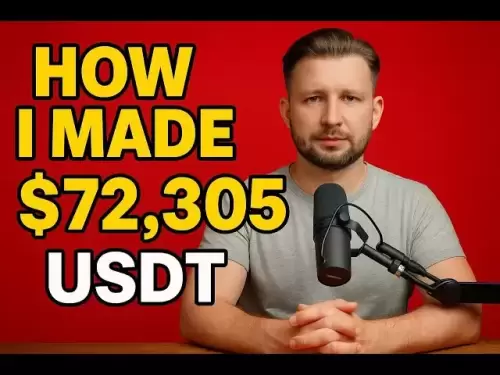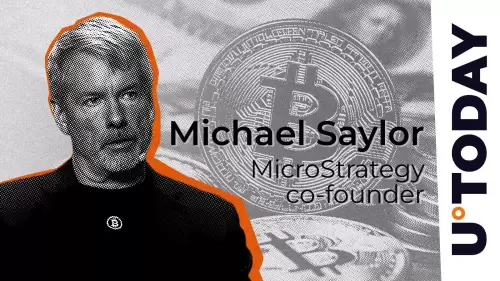 |
|
 |
|
 |
|
 |
|
 |
|
 |
|
 |
|
 |
|
 |
|
 |
|
 |
|
 |
|
 |
|
 |
|
 |
|
Cryptocurrency News Articles
Despite Donald Trump's Disruptive Tariff Policy, Bitcoin Outperformed Both Gold and the S&P 500 in April
May 16, 2025 at 09:50 pm
April was a highly disruptive month for the global economy, affecting multiple markets — including crypto. The primary catalyst was Donald Trump’s aggressive tariff policy

April was a highly disruptive month for the global economy, affecting multiple markets — including crypto.
One primary catalyst was Donald Trump’s aggressive tariff policy, which signaled a potential rewiring of global supply chains and trade dynamics.
While Trump had long voiced support for tariffs, the speed and boldness of his implementation surprised many.
Eventually, he opted for a more gradual approach, easing some of the market panic.
Trump’s policy shifts left a clear footprint on the price movements of major asset classes. Let’s walk through the key events and observe their impact on Bitcoin, the S&P 500, and gold.
Timeline of Events and Market Reactions
April 2 At a White House Rose Garden event dubbed “Liberation Day,” Trump unveiled a “reciprocal tariff” policy. A blanket 10% tariff was imposed on all nations exporting to the U.S., with steeper rates for specific countries — including close allies.
Following this, both the S&P 500 and Bitcoin extended their March declines. Even gold, which had previously risen as a risk hedge during equity sell-offs, began to dip.
April 4 China retaliated with a 34% tariff on U.S. imports and banned 11 American companies from operating domestically.
The tit-for-tat escalation deepened market anxiety, accelerating the sell-off across equities and crypto.
April 9 Trump’s tariffs took effect: 104% on Chinese goods, 20% on EU goods, 24% on Japanese, and 46% on Vietnamese imports. China responded with an 84% tariff on U.S. goods. The EU also threatened countermeasures.
Markets plummeted globally, with some indices experiencing losses not seen in decades. Later that day, Trump announced a 90-day pause on most tariffs — except those on China, which were increased to 125%.
This reversal sparked a relief rally across markets.
April 10 The White House clarified the full tariff rate on Chinese goods as 145%. The EU temporarily paused its retaliatory measures.
Markets reacted negatively, with a slight pullback in the S&P 500 and Bitcoin, while gold resumed its upward trajectory.
April 11 Trump exempted several categories of electronics — including smartphones and semiconductors — from tariffs. This eased investor concerns and helped Bitcoin and the S&P 500 recover the previous day’s losses.
April 13 The White House announced that electronics exemptions were only temporary and hinted at new tariffs on computer chips. By now, markets showed signs of fatigue, appearing less reactive to sector-specific tariff news. Gold continued to climb as a hedge, while Bitcoin and equities diverged temporarily until April 21, when they synchronized again amid renewed S&P 500 growth. Bitcoin demonstrated a higher upside response.
April 29 Trump signed executive orders adjusting auto industry tariffs to avoid overlap with existing duties on steel and aluminum.
Markets appeared to await more decisive signals. Cautious optimism emerged, hinging on whether the 90-day pause would lead to lasting de-escalation.
Conclusion
The data show that Trump’s tariff policy left a clear footprint on the price patterns of the S&P 500, Bitcoin, and gold. Compared to the S&P 500, Bitcoin showed notably stronger momentum. Despite a sharp decline early in the month, Bitcoin outperformed both gold and the S&P 500 in April.
The correlation between Bitcoin and the S&P 500 remains strong. In fact, the S&P 500 only slightly outpaced Bitcoin, indicating that BTC closely tracks the index’s movements.
The takeaway is clear and optimistic: Bitcoin mirrors the S&P 500’s behavior but with higher alpha.
Bitcoin
Bitcoin showed significant price growth in April and demonstrated a strong ability to rebound quickly. So far, April has been the best-performing month for Bitcoin in 2025 in terms of price increase — partly due to a low base effect and a recovery from the February dip.
Additional indirect indicators also point to rising demand for Bitcoin. Currently, the amount of Bitcoin held on centralized exchanges (CEXs) has dropped to its lowest level in five years. Historically, such declines have often preceded price increases, as illustrated in the chart.
Since the launch of spot Bitcoin ETFs, we’ve seen a gradual increase in the number of Bitcoins held by these funds. Notably, demand for Bitcoin ETFs tends to rise ahead of major events — such as the halving and the U.S. presidential elections. Outside of those periods, the number of Bitcoins held in ETFs has remained relatively stable.
Several conclusions can be drawn from this:
The number of Bitcoin in ETFs is steadily growing. So far
Disclaimer:info@kdj.com
The information provided is not trading advice. kdj.com does not assume any responsibility for any investments made based on the information provided in this article. Cryptocurrencies are highly volatile and it is highly recommended that you invest with caution after thorough research!
If you believe that the content used on this website infringes your copyright, please contact us immediately (info@kdj.com) and we will delete it promptly.
-

-

-

-

-

-

-

- Bitcoin (BTC) Featured in Michael Saylor's Book of Finance
- May 17, 2025 at 09:30 am
- Michael Saylor, a prominent Bitcoin advocate and chairman of the renowned investment firm Strategy (formerly MicroStrategy), in his usual adulation for Bitcoin, has acknowledged Bitcoin as a key contributor to Strategy's financial success.
-

-






























































